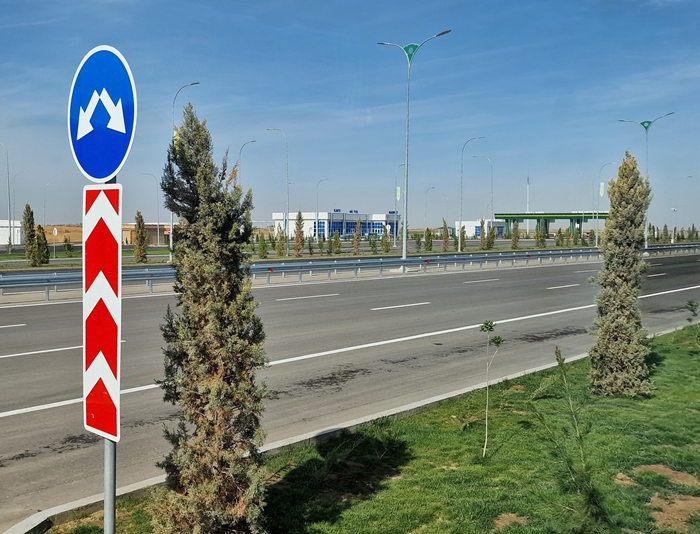Elvira Kadyrova and Raviliya Kadyrova
It is road to prosperity. It is road to partnership. It is the Ashgabat-Turkmenabat highway, the second section of which was inaugurated on 17 April 2024 in a ceremony led by President Serdar Berdimuhamedov.
The 109km segment of the highway that was opened in the presence of the top government officials, heads of diplomatic missions based in Turkmenistan, the notable citizens, the foreign guests and the international and local media, underlines the commitment of Turkmenistan to create well-rounded connectivity across its territory.
The construction of the Ashgabat-Turkmenabat highway, 600 kilometers long, started on January 24, 2019. Work on its construction is carried out in three stages: Ashgabat-Tejen (203 kilometers), Tejen-Mary (109 kilometers) and Mary-Turkmenabat (288 kilometers).
The first section of the high-speed highway – Ashgabat-Tejen was commissioned with the participation of the National Leader of Turkmenistan, Gurbanguly Berdimuhamedov in October 2021.
The second section, Tejen-Mary, has opened now.
The construction of the last section – Mary-Turkmenabat – started in January 2024.
The highway is being built by the Turkmen Autobahn CJSC, and private enterprises are subcontractors.
The total cost of the project is US $ 2.5 billion.
The autobahn, consisting of six lanes, is equipped with a special traffic management system with real-time video surveillance for effective road supervision.
The fare on the autobahn varies from 0.35 to 0.45 manats per kilometer, depending on the type of transport.
This highway is a manifestation of the holistic approach of Turkmenistan – everything is connected with everything else. This is also one of the messages of Magtymguly Fragi, the national poet of Turkmenistan, whose 300th anniversary is being celebrated this year.
On 16 April 2024, just a day before the opening of the Tejen-Mary section of the Ashgabat-Turkmenistan highway, the first Ministerial meeting of the Group of Friends of Sustainable Transport was held at the UN headquarters under the chairmanship of Turkmenistan.
It was a panoramic meeting, as can be seen from the list of participants.
The meeting was attended by the Permanent Representative of Turkmenistan to the UN Aksoltan Atayeva, Chairman of the Türkmendeňizderýaýollary Agency Batyr Annaev, heads of transport departments, heads and representatives of diplomatic missions to the UN of the Group member countries, UN Deputy Secretary-General for Economic and Social Affairs (UNDESA) Li Junhua , Special Envoy of the UN Secretary-General for Road Safety Jean Todt, Secretary General of the SLOCAT Partnership for Sustainable Low-Carbon Transport Marusha Kardama, President of the Turkic Investment Fund Baghdad Amreev, Chairman of the Advisory Council of the Group of Friends of Sustainable Transport, Honorary Chairman of the International Road Transport Union Martin Marmy, Executive Secretary International Center for Transport Diplomacy (ICTD) Igor Runov, as well as invited Permanent Missions from among the co-authors of UN General Assembly resolutions on transport issues, representatives of research institutes and academic circles.
Among the topics discussed was the preparation for the UN Decade on Sustainable Transport (2026-2035).
It is important to point out that Turkmenistan considers the Transport Diplomacy as an integral part of diplomacy. The country has the Transport Diplomacy Development Program of the President of Turkmenistan for 2022-2025.
The meeting in New York included the inaugural session of the Advisory Council of the Group of Friends of Sustainable Transport, formed in 2023. Chairman of the Council Martin Marmy voiced promising areas of future activity of the Council and shared plans to involve the business community in joint work with the Group of Friends and building effective public-private interaction in this regard.
The Ashgabat-Turkmenabat highway is essentially the Turkmenbashi-Farab highway – the East-West connectivity from the border with Uzbekistan to the coast of the Caspian Sea.
The high speed road, equipped with the latest safety features, is the conduit for the cargo from Uzbekistan, Tajikistan, China, Afghanistan and South Asia to the Turkmenbashi Port and ultimately to any destination in Caucasus and Europe.
In the North-South dimension, it is the lateral conduit for the cargo between the Middle East and Central Asia.
The Turkmenbashi-Farab highway adds to the viability and attractiveness of the Middle Corridor, the Central Asia – Middle – East Corridor, the Lapis Lazuli Corridor (Afghanistan-Turkmenistan-Azerbaijan-Georgia-Türkiye), North-South Corridor and two other corridors that may start appearing in the foreseeable future. /// nCa, 18 April 2024
